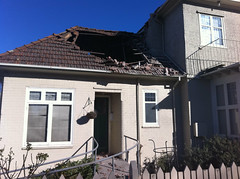
Search
Images for hole; more images...
Chimney hole
Images, eqnz.chch.2010
None
earthquake + brick chimney = hole in roof
Images, eqnz.chch.2010
Our neighbours, Laura and Robbie, were unlucky enough to have their chimney fall into the roof rather than off the house.
BeckerFraserPhotos September 2010 photograph 060
Images, UC QuakeStudies
A hole in the side of the road along Avonside Drive. A blue pipe can be seen inside the hole. Pipes like this were used to provide temporary water supplies to the neighbourhood while the water system was being repaired.
BeckerFraserPhotos November 2010 photograph 32
Images, UC QuakeStudies
A hole in a broken driveway along Avonside drive with a rubbish bin fallen in.
BeckerFraserPhotos October 2010 photograph 056
Images, UC QuakeStudies
A collapsed wall above the windows of a brick house on Centaurus Road. Bricks have fallen into the building and left a hole.
BeckerFraserPhotos September 2010 photograph 045
Images, UC QuakeStudies
The roof of St John the Baptist Church on Latimer Square. Masonry has tumbled into the building, tearing a hole in the roof and exposing the inside of the church.
BeckerFraserPhotos October 2010 photograph 003
Images, UC QuakeStudies
A typical "sand volcano" caused by liquefaction where the soil loses its strength during the earthquake and the silt rises upwards, ejecting out of a hole like magma in a volcano.
Kim Wright WEMO Photograph 051
Images, UC QuakeStudies
A photograph of earthquake damage to a road in Christchurch. A hole has been filled with gravel, and a road cone placed on top. In the background, cracks and liquefaction can be seen.
BeckerFraserPhotos November 2010 photograph 38
Images, UC QuakeStudies
The dairy on the corner of Woodham and Gloucester Street. The top wall has collapsed onto the footpath, the hole covered by a tarpaulin. Road cones and fencing have been placed around the building.
BeckerFraserPhotos October 2010 photograph 028
Images, UC QuakeStudies
The collapsed brick wall along the side of a house in Christchurch. A tarpaulin has been placed over a hole to prevent weather damage to the inside of the building. Ironically, it is being held down by bricks.
BeckerFraserPhotos October 2010 photograph 020
Images, UC QuakeStudies
The damaged stone work of the Octagon Live Restaurant on the corner of Manchester and Worcester Streets. A tarpaulin has been used to cover the hole and protect the inside of the building from weather damage.
BeckerFraserPhotos September 2010 photograph 090
Images, UC QuakeStudies
A sand volcano in the Halswell Primary School grounds. Sand volcanoes were caused by liquefaction where the soil loses its strength during the earthquake and the silt rises upwards, ejecting out of a hole like magma in a volcano.
BeckerFraserPhotos September 2010 photograph 088
Images, UC QuakeStudies
A sand volcano in the Halswell Primary School grounds near the playground. Sand volcanoes were caused by liquefaction where the soil loses its strength during the earthquake and the silt rises upwards, ejecting out of a hole like magma in a volcano.
BeckerFraserPhotos October 2010 photograph 090
Images, UC QuakeStudies
The driveway of a house on Avonside Drive. One of the concrete slabs has lifted and the owner has tried to fill the gap with blocks of wood. Unfortunately, these have come loose and are sticking out of the hole.
Kim Wright WEMO Photograph 020
Images, UC QuakeStudies
A photograph of the earthquake damage to the Cranmer Courts on the corner of Montreal and Kilmore Streets. On of the gables has crumbled, the masonry falling to the footpath. A tarpaulin has been used to cover the hole.
BeckerFraserPhotos November 2010 photograph 39
Images, UC QuakeStudies
A dairy on the corner of Gloucester and Woodham Streets. The top wall of the building has crumbled onto the street. A tarpaulin has been placed over the hole to prevent weather damage inside the building. Fencing and road cones cordon off the building along the street.
BeckerFraserPhotos October 2010 photograph 033
Images, UC QuakeStudies
St Luke's church on the corner of Manchester and Kilmore Streets. Tape and fencing have been placed around the building to keep people away. There is damage to the top of the gable, and tarpaulins covering the hole to prevent weather damage to the inside of the building.
Kim Wright WEMO Photograph 054
Images, UC QuakeStudies
A photograph of the earthquake damage to the entrance of a driveway on Glenarm Terrace. A large hole in the foreground has had a road cone placed inside it. Other large cracks and liquefaction can bee seen. A man in overalls has parked his van next to the damage.
sealing the roof
Images, eqnz.chch.2010
Laura Young and I tying down tarps over the hole in the roof. We did what we could to tie it down with tension and weigh it down with bricks tied to the tarps. Why? Because gale-force winds are predicted for tomorrow (Sunday) and rain on Tuesday.
Kim Wright WEMO Photograph 022
Images, UC QuakeStudies
A photograph of the earthquake damage to the Cranmer Courts on the corner of Montreal and Kilmore Streets. A chimney has fallen from the roof, damaging many of the roof tiles. A tarpaulin has been placed over a hole to protect the interior of the building from weather damage. Wire fencing has been placed around the building as a cordon.
- 1

